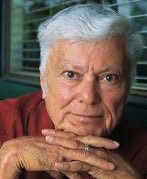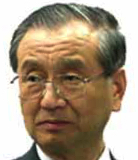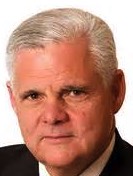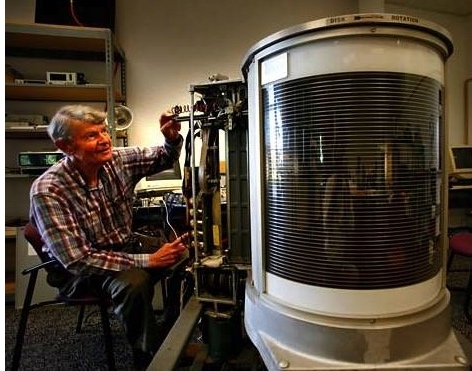Top 10 Most Prestigious Names in History of Storage Industry
Top 5 today (Al Shugart, Fujio Masuoka, Joe Tucci, Ramac 350, Veritas), 6 to 10 tomorrow
By Jean Jacques Maleval | December 27, 2016 at 3:05 pmHere is a subjective choice of StorageNewsLetter.com‘s editor, journalist on storage without interruption since 1988.
Here are the Top 5 most prestigious names
in the history of the storage industry, published with details today:
- # 1 Al Shugart
- # 2 Fujio Masuoka
- # 3 Joe Tucci
- # 4 Ramac 350
- # 5 Veritas
Tomorrow we will publish the next five ones, Top 6 to Top 10:
- # 6 RAID inventors
- # 7 Moshe Yanai
- # 8 Dan Warmenhoven
- # 9 Dr. Eli Harari
- # 10 Jim Porter
#1 Al Shugart, Seagate
Alan Field Shugart, born in Los Angeles September 27, 1930, was an U.S. engineer, entrepreneur and business executive whose career defined the modern HDD industry.
He graduated from the University of Redlands, receiving a degree in engineering physics. He began his career in 1951 as a field engineer at IBM and, in 1955, he transferred to the IBM San Jose laboratory where he worked on the first HDD IBM 305 RAMAC. He joined Memorex in 1969 as VP of its equipment division and led the development of the 3660 (compatible with IBM 2314) and 3670 models (compatible with IBM 3330) of disk storage subsystems. His team also developed the Memorex 650, one of the first commercially available floppy disk drives.
He founded Shugart Associates, pioneer in 5.25-inch floppy disk drives, in February 1973, and resigned as CEO in October 1974. The company was later acquired by Xerox. Then he, Finis Conner, Doug Mahon and Tom Mitchell started Shugart Technology in 1979, which soon changed its name to Seagate Technology.
With Alan Shugart as CEO, Seagate launches in 1980 the first 5.25-inch HDD for PC and became the world’s largest manufacturer of disk drives until the acquisition of HGST by Western Digital in 2011.
Becoming less efficient, he was ousted unceremoniously by the board in July 1998 and replaced by Steve Luczo at the head of the company. Seagate became ‘Shugart-Free.’
Shugart had some strange political activities: in 1996 he launched an unsuccessful campaign to elect Ernest, his Bernese Mountain Dog, to Congress. He later wrote about that experience in a book, Ernest Goes to Washington. He backed a failed ballot initiative in 2000 to give California voters the option of choosing “none of the above” in elections.
Rare where the times when Shugart dresses in suit and tie – his preference was for short-sleeves shirts and open collars.
We published six interviews of Shugart in ten years. He was always available, taking all questions with apparent candor, despite the fact that during our last interview, he admitted he doesn’t much like talking to the press.
He received the 1997 IEEE Reynold B. Johnson Information Storage Systems Award. In 2005, he was made a Fellow of the Computer History Museum.
He died on December 12, 2006 in Monterey, CA of complications from heart surgery he had undergone six weeks earlier.
#2 Fujio Masuoka, Inventor of Flash Memory, Toshiba
Dr. Fujio Masuoka, born May 8, 1943 in Takasaki, Gunma, Japan, is the inventor of the base technology of flash memory.
He joined Toshiba in 1971 and was excited mostly by the idea of non-volatile memory, memory that would last even when power was turned off, not like RAM but much faster than HDDs. This technology finally got an enormous success, being integrated in all USB keys, portable phones, SSDs, etc.
It should have made Masuoka very rich, but his employer, Toshiba, recognized his efforts by awarding him a bonus worth only “few hundred dollars” and promptly let its archrival Intel and others take control of the market for his invention. Subsequently, Masuoka says Toshiba tried repeatedly to move him from his senior post to a position where he could do no further research.
Masuoka received the 1997 IEEE Morris N. Liebmann Memorial Award of the Institute of Electrical and Electronic Engineers. Since 2005, he has been working as CTO of Unisantis Electronics aiming to develop a three-dimensional transistor.
He is a professor at Tohoku University in Sendai, Japan.
We hesitate to choose between Richard (Dick) Egan, Michael C. Ruettgers and Joseph (Joe) M. Tucci, the three EMC big executives of the biggest storage company for many years since the acquisition by Dell.
Co-founder Egan was president and CEO until 1992, and became COB in 1998 until 2001. He shot himself in the head with a gun in August 2009, after fighting against terminal lung cancer.
Ruettgers, now 73, served as executive chairman from 2001 to 2004, chairman from 2004 to 2005, CEO from 1992 to 2001 and president from 1989 to 2000.
Born in 1947, Tucci was EMC’s chairman since 2006 and president and CEO since 2001, one year after joining the company as president and COO. Under his leadership, the company approaches $25 billion in revenue in FY15 but with a moderate growth these past years.
Tucci was not a technological expert but was remarkable to hire remarkable executives around him, to acquire excellent companies and to integrate them smoothly. Since 2001, his company acquired 74 firms in storage only.
The best operation was the acquisition of VMware in 2006 in a cash transaction of approximately $635 million and you can add Data Domain, Documentum, Isilon, RSA, XtremIO among others, as EMC prefered to acquire technologies rather than to invent them.
He got a $27 million golden parachute for selling EMC to Dell and left the company to become probably the healthiest man in storage industry.
It was on September 14, 1956 when IBM published a press release announcing the first computer disk unit, the Ramac 350 (Random Access Method of Accounting and Control), a major component of IBM 305 Ramac computer system.
The inventors were especially William A Goddard and John J Lynott, assignees of the US patent 3503060 A, Direct access magnetic disc storage device.
The unit consists of an enormous device 60 inches (152cm) long, 68 inches (172cm) high and 29 inches (74cm) deep with a gigantic electric motor attached to a solid axis that held 50 coated aluminum disks – or 100 surfaces – one inch thick and 24 inches (610mm) in diameter, for a mere 5MB raw capacity or 4.4 million characters.
Fourteen prototype Ramac systems, known as 305As, were built for trial use and internal testing. The first delivery to a customer site occurred in June 1956, to the Zellerbach Paper company, in San Francisco, CA. This file (a term that persisted for many years in IBM jargon, as opposed to ‘drive’) was rented, with an entire system consisting of processor, card punch, printer and console, the whole renting for $3,200 per month, an attractively low price at the time. IBM asserts that the single drive was worth $50,000 or $11,364/MB in 1956.
1,067 model 305s were built in San Jose before production ended in 1961.
RAMAC had a lot of children. The first statistics on the HDD market were published in 1976 with 176,000 units shipped during the year. From 1976 to 2015, the total global figure is a little less that 8 billion, more precisely 7,951,135,000 disk drives sold, according to addition of the the data of Disk/Trend and then Trendfocus.
#5 Veritas for Storage Software

At a time, Veritas had the best software engineers in the history of the storage software industry.
Veritas Technologies was founded in 1983 as Tolerant Systems, renamed Veritas Software in 1989. It was headquartered in Mountain View, CA. The company specialized in storage management software including the first commercial journaling file system, VxFS, VxVM, VCS, the personal/small office backup software Backup Exec and the popular enterprise backup software, NetBackup, according to Wikipedia.
On December 16, 2004, Veritas and Symantec announced their plans for a merger in a deal valued at $13.5 billion. It was the largest announced software industry merger to date. But it was the end of the great software innovations.
On October 10, 2014, Symantec announced the split of the company into two parts: the security business remaining with Symantec, and the information management business to be known as Veritas Technologies. The separation of the companies was completed on January 29, 2016.
On August 11, 2015 Symantec announced the sale of its Veritas information management business to The Carlyle Group. Veritas and Symantec achieved operational separation on October 1, 2015. The sale was completed January 30, 2016 when Veritas Technologies became a privately-held company.

















 Subscribe to our free daily newsletter
Subscribe to our free daily newsletter

